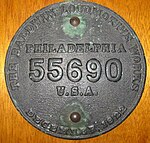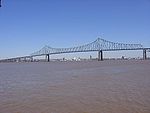Bridgeport Speedway
Buildings and structures in Gloucester County, New JerseyLogan Township, New JerseyMotorsport venues in New JerseyTourist attractions in Gloucester County, New Jersey

Bridgeport Speedway is a dirt speedway located in the community of Bridgeport in Logan Township, Gloucester County, New Jersey, that consists of a high banked, progressive 4/10 mile 0.375-mile (0.604 km) and a 1/4 mile 0.25-mile (0.40 km) oval located within the bigger track. The Super DIRTcar Series races at the track. Jason Leffler died in an accident at the track in 2013.
Excerpt from the Wikipedia article Bridgeport Speedway (License: CC BY-SA 3.0, Authors, Images).Bridgeport Speedway
Flood Gate Road,
Geographical coordinates (GPS) Address Phone number Website Nearby Places Show on map
Geographical coordinates (GPS)
| Latitude | Longitude |
|---|---|
| N 39.819166666667 ° | E -75.317777777778 ° |
Address
Bridgeport Speedway
Flood Gate Road 83
08085
New Jersey, United States
Open on Google Maps








